Italian Easter Cheese Bread
Italian Easter Cheese Bread, also known as “Crescia di Pasqua” is a traditional savory Easter bread that is a much loved part of the Italian cuisine. This delicious bread is made with a combination of cheeses and is often served as a savory accompaniment to Easter meals.
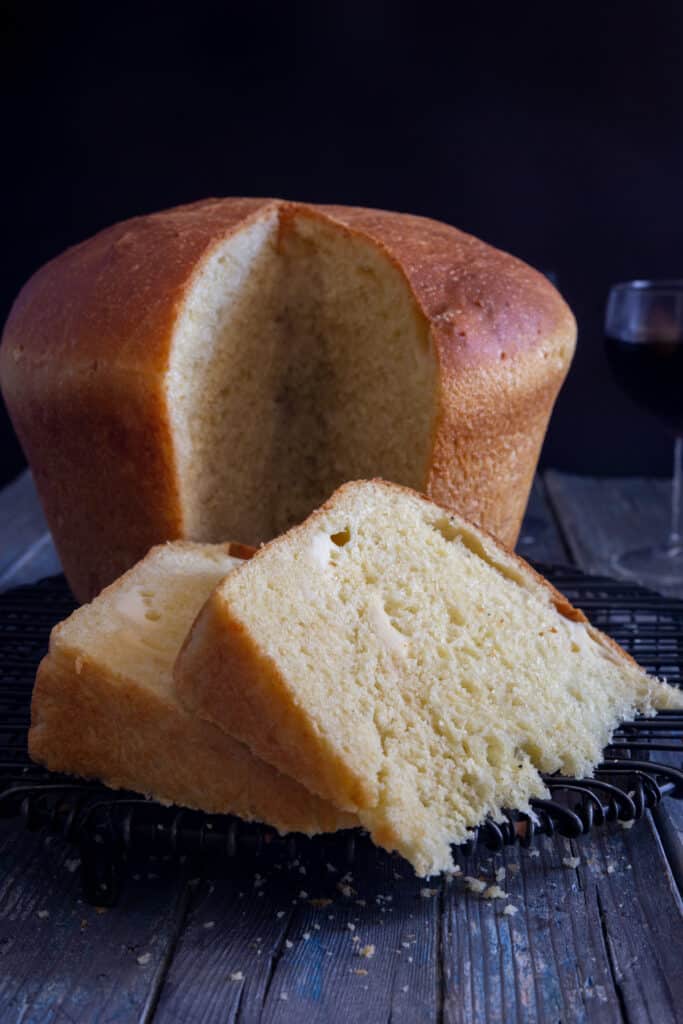
This bread is a typical recipe from the Region of Marche that is prepared for Easter! It is a savory leavened bread that is enriched with grated Parmigiano Reggiano, Pecorino cheese and cubes of fresh cheese. My father-in-law was from Marche, so my mother-in-law would make this bread every Easter.
Different types of bread are actually very popular in Italy during the Easter season, basically every region has their own, from a Traditional Easter bread, to a Calabrian Bread, to this Roman Bread and of course don’t forget the most important of all Colomba – Dove Bread.
Recipe Ingredients
- Water – lukewarm water
- Sugar – just a teaspoon of granulated sugar or honey
- Yeast – active dry yeast
- Flour – all purpose or Italian 0 flour
- Parmesan – freshly grated Parmesan cheese
- Pecorino – freshly grated Pecorino cheese
- Milk – lukewarm either whole or 2% milk
- Eggs – room temperature large eggs
- Egg yolk – one large egg yolk room temperature
- Olive oil – a light olive oil
- Pepper
- Salt – if your pecorino is very salty cut back on the salt
- Cheese – you can use Swiss, Gruyere, Fontina or even Provolone

What temperature is lukewarm?
Lukewarm is considered between 105-110F (40-43C). Be aware that the yeast will die at a temperature over 140F (60C).
How to make an Italian Easter Cheese Bread
In a small bowl stir together the water and the sugar, sprinkle the yeast on top and let sit for 10 minutes, then stir to combine.
In the bowl of the stand mixer whisk together the flour, Parmesan cheese, and Pecorino Romano cheese, add the milk, eggs, egg yolk, olive oil and yeast mixture. With the dough hook attachment start to knead on low speed, then add the pepper and salt.
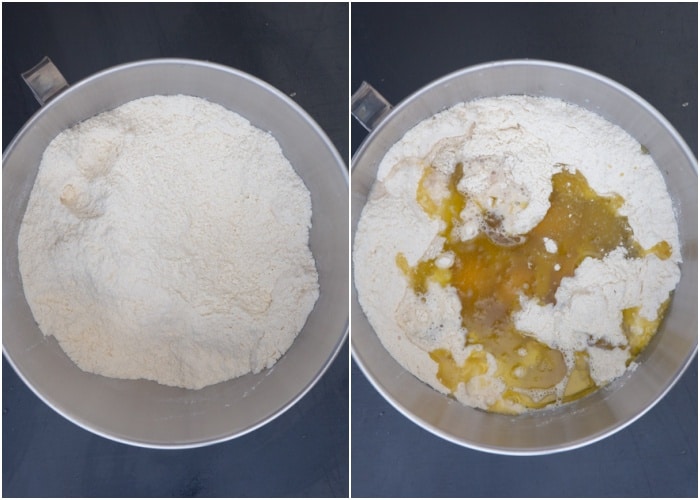
Continue to knead on speed #2 until the dough is smooth and elastic.

Move the dough to a lightly floured flat surface and form it into a ball and place in a lightly oiled bowl.

Place the bowl in a warm draft free area and let rise until doubled.
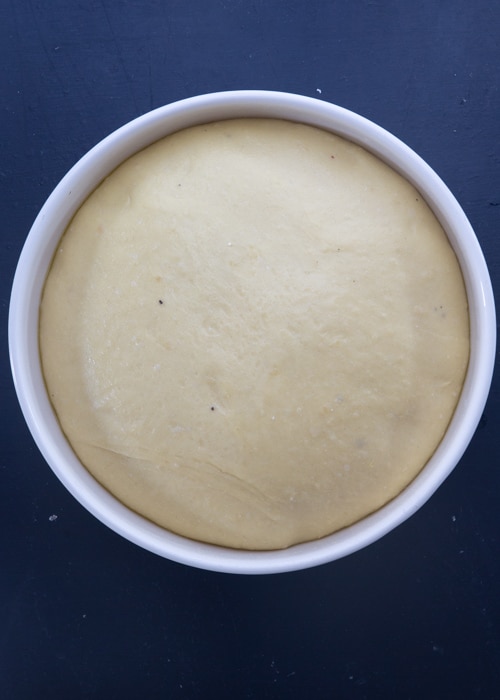
Move the dough to a lightly floured flat surface, gently pat into a rectangle, sprinkle the cubed cheese on top.
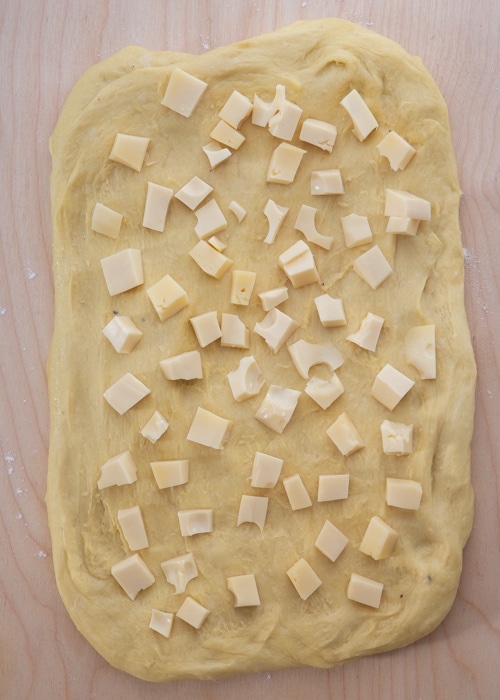
Gather the ends together then gently form the dough into a ball.
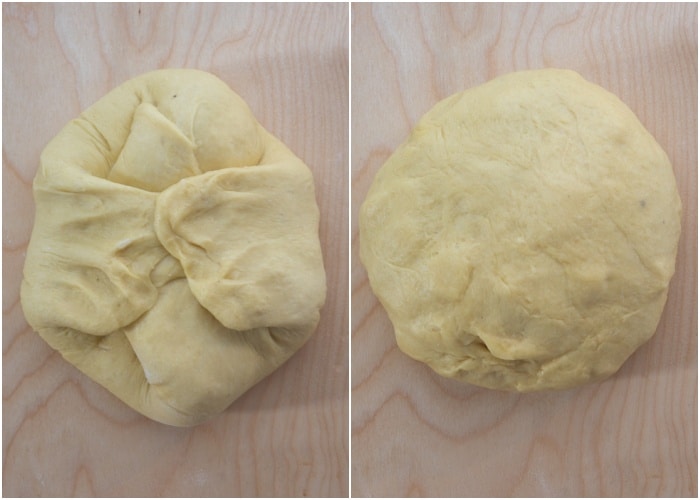
Place the ball into the prepared high sided pan and let rise until the bread reaches the top of the rim.

Bake in the pre-heated oven until golden brown and cooked through. Allow the bread to cool on a wire rack before slicing and serving.

What is authentic Parmesan?
Parmigiano Reggiano cheese is authentic or DOP (Denominazione di Origine Protetta which means Protected Designation of Origin), and Parmesan cheese is just an imitation of Parmigiano Reggiano.
Reggiano is always made in Italy, while Parmesan can be made anywhere, there are no restrictions on using the name Parmesan. And don’t forget a less expensive but also a DOP choice is Parmigiano Grana Padano.
Why grate your own Parmesan Cheese?
A couple of reasons it’s better to grate your own. It’s cheaper and it tastes so much better. Packaged cheese tends to have a coating to keep the cheese from sticking together. Not a good thing.
You can grate your own cheese with either a Cheese Grater or by placing chunks in your Food Processor and just pulsing a few times until coarsely ground.
Freshly ground parmesan cheese can be kept in a plastic bag or airtight container and stored in the fridge for up to two weeks. You can also store it in the freezer for up to 18 months.
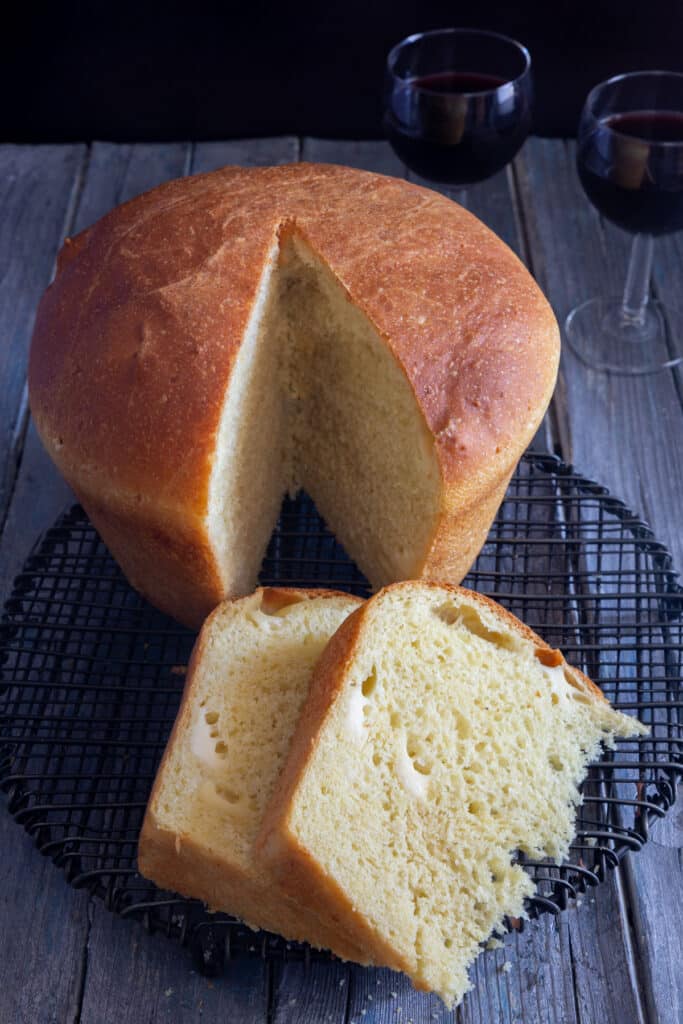
The origin of La Crescia di Pasqua
Believed to have its roots in the ancient monastery of Santa Maria Maddalena in Serra de’ Conti, in the province of Ancona. In the monastery there are still the first documents showing the original recipe of Crescia.
The name Crescia (meaning grow in English), comes from the increase in volume of the dough from the yeast. Of course like any traditional and typical recipe from a region, there are different variations and versions, handed down from generation to generation!
How to serve the Cheese Bread
Italian Easter Cheese Bread is typically served as an accompaniment to Easter breakfast, brunch or the midday Easter meal. But why not serve it as a delicious snack or appetizer with some salami, cheese and or prosciutto!
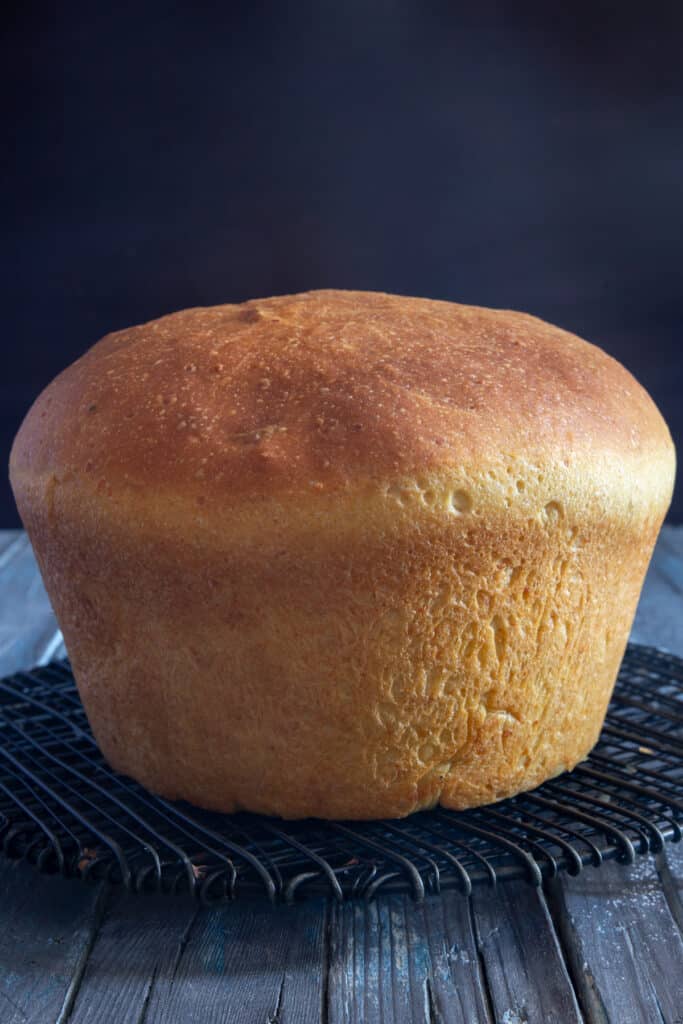
How to store the Cheese Bread
Leftovers should be wrapped well in plastic wrap and placed in an airtight container. It will keep at room temperature away from drafts for one day. It is probably best to refrigerate. It will keep for up to 3-4 days in the fridge. It can be re-heated in the oven or microwave.
How to freeze the bread
Place the completely cooled bread in a freezer bag or container. It will keep for up to two months in the freezer. Thaw overnight in the fridge, then re-heat in the oven or microwave.
Italian Easter Cheese Bread is a delicious and traditional Italian dish that is perfect for Easter breakfast, brunch or even dinner. This bread is easy to make and is sure to impress your family and friends. So why not try making this delicious bread for your next Easter celebration? Enjoy!
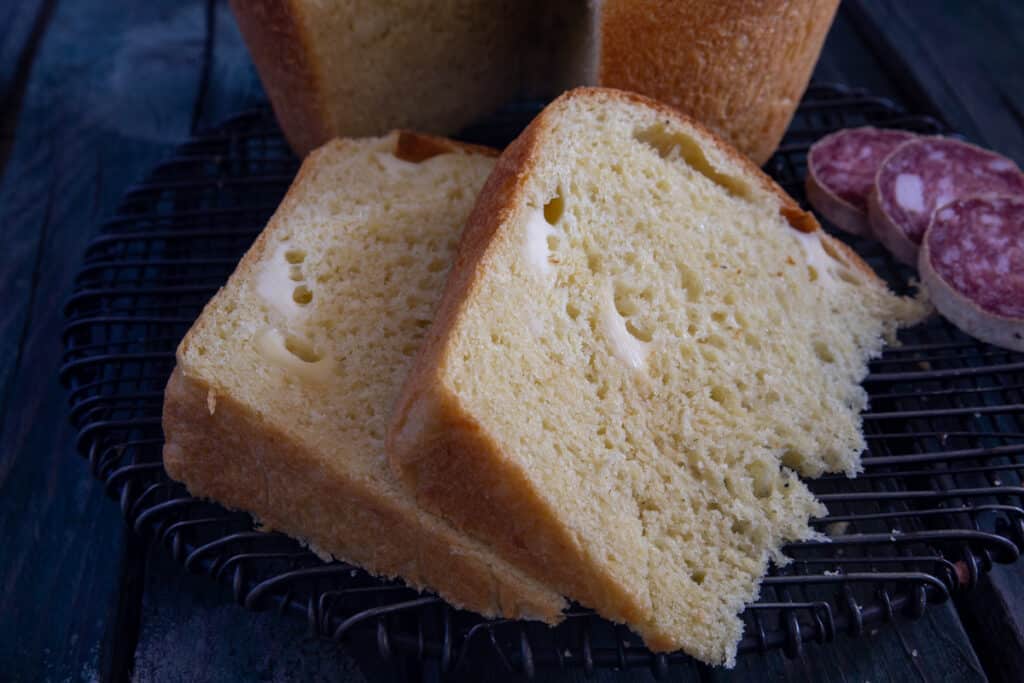

Italian Easter Cheese Bread
Equipment
- 1 stand mixer
- 1 8×4 inch/ 21cm round pan
Ingredients
- 3½ tablespoons water lukewarm
- 1 teaspoon granulated sugar or honey
- 1½ teaspoons active dry yeast
- 4 cups +1½ tablespoons all purpose flour or Italian 0 flour (512 grams total)
- 1¼ cups freshly grated parmesan cheese
- ¾ cup freshly grated pecorino cheese
- ⅓ cup + 1¼ tablespoons milk lukewarm (2% or whole milk) (100 grams total)
- 3 large eggs room temperature
- 1 large egg yolk room temperature
- ½ cup light olive oil
- 3-4 dashes black pepper (more or less)
- 1½ teaspoons salt
- 5¼ ounces Swiss, gruyere, fontina or Provolone cheese (cubed small/medium) 150
Instructions
- In a small bowl stir together the water and the sugar, sprinkle the yeast on top and let sit for 10 minutes, then stir to combine.
- In the bowl of the stand mixer whisk together the flour, Parmesan cheese, and Pecorino Romano cheese, add the milk, eggs, egg yolk, olive oil and yeast mixture. With the dough hook attachment start to knead on low speed, then add the pepper and salt, continue to knead on speed #2 until the dough is smooth and elastic, approximately 10-12 minutes.
- Move the dough to a lightly floured flat surface and form it into a ball, place the dough ball in a lightly oiled bowl. Cover the bowl with plastic wrap and place it in a warm draft free area and let rise until doubled, approximately 2 hours.
- Move the dough again to a lightly floured flat surface, gently pat it into a thick rectangle, sprinkle the cubed cheese on top gather the ends of the dough to cover the cheese, then form the dough into a ball.
- Place the ball into the a greased and floured or sprayed 8×4 inch/ 21×11 cm round cake pan and let rise until the bread reaches the top of the rim, approximately 2-4 hours. This will depend on the warmth of your house.
- Pre-heat the oven to 350F (180C).
- Bake in the pre-heated oven until golden brown approximately 40-45 minutes. The bread is done when the internal temperature is 190F/88C. Allow the bread to cool on a wire rack before slicing and serving.
Can I make this in a loaf tin please as I can’t get a tin that you describe in your recipe. It sounds just what I want too. Thank you. Sue
Hi Susan, sure that would also. I hope you enjoy it. Take care.